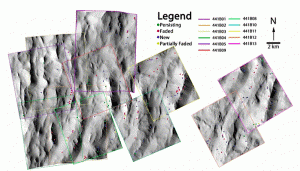Slope streaks are dark lines that run down dusty slopes on Mars; scientists explain them as dust avalanches touched off by rockfalls or some similar trigger. (Slope streaks differ in nature and cause from a different kind of streak, dubbed “recurring slope lineae,” which are also dark but are probably caused by seeps of liquid brine.)

GOING.…GOING… Lycus Sulci offers an abundance of slope streaks whose varying ages helped determine the average streak has a lifetime measured in a few decades. (Image is Figure 1 from the paper.)
A new study of slope streaks, led by Norbert Schorghofer (University of Hawaii), combined 30- to 33-year-old Viking Orbiter images with more recent ones (2007-2010) taken by the Context Camera (CTX) on the Mars Reconnaissance Orbiter. The scientists found that slope streaks are in a more or less steady-state and have an average lifetime estimated to be around four decades.
The report (PDF) was given at the 43rd Lunar and Planetary Science Conference in The Woodlands, Texas.
Earlier work by others had suggested that slope streaks were forming more rapidly in recent years, thus becoming more common. However, the Schorghofer team found that when they examined the Viking record more carefully, the surge of streaks over recent years proved an illusion caused by the higher resolution of newer images. When CTX and Viking images of the same areas were compared at similar resolution, the effect went away.
Still, puzzles remain. Interestingly, the researchers found that the big global dust storm of 2001 did not erase the population of slope streaks. In addition, in their Lycus Sulci study area, the team found “islands of persistence” — locations where for some reason streaks lingered longer than elsewhere.
And finally the team noted, “On the smaller scale of individual streaks, we identified no common pattern for partially faded streaks. They fade from the head or the tail or from the outside toward the interior.”








